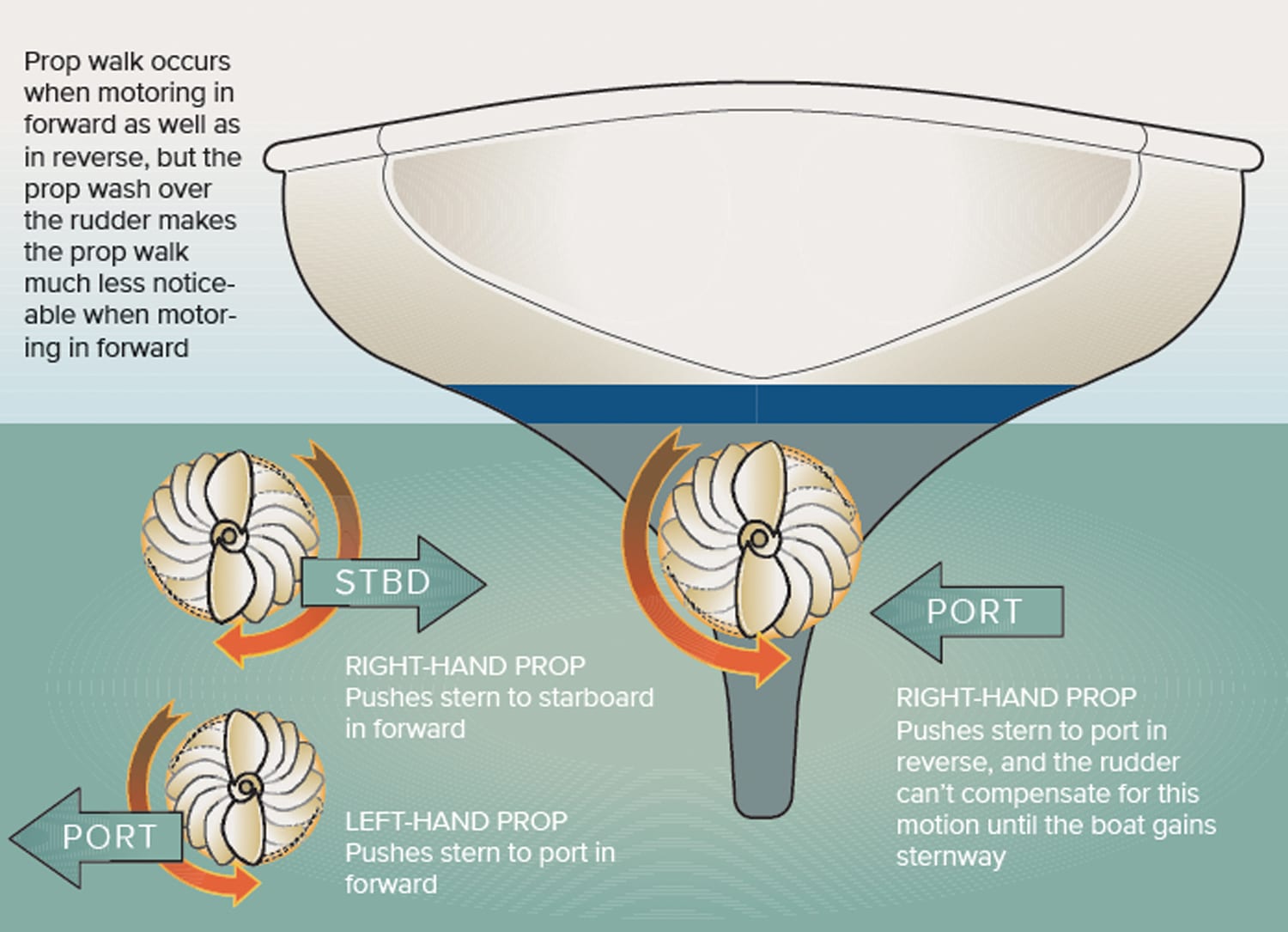Handling Propeller Walk
- Propeller walk (or “prop walk”) is a phenomenon that occurs when a boat moves sideways due to the interaction between the propeller’s thrust and the hull while the boat is in reverse. Here’s a detailed explanation of prop walk and its effects:
What is Prop Walk?
- Definition:
- Prop Walk: It refers to the tendency of the stern of a boat to move sideways in the opposite direction of the propeller’s rotation when the boat is in reverse. (Read more about reversing your boat). This effect results from how the propeller pushes water and how that water interacts with the boat’s hull.
- Mechanism:
- Thrust and Water Flow: When the propeller rotates in reverse, it pushes water forward. Due to the asymmetrical water flow around the hull and propeller, this thrust creates a sideways force on the stern. This force causes the stern to move opposite to the propeller’s rotation.
- Direction of Movement: For a right-handed propeller (which rotates clockwise when viewed from behind), the stern typically moves to port (left) when in reverse. For a left-handed propeller (which rotates counter clockwise), the stern typically moves to starboard (right) in reverse.
- Definition:

Factors Influencing Prop Walk
- Propeller Rotation:
- Right-Handed Propeller: Most boats use right-handed propellers, which turn clockwise. When these propellers rotate in reverse, they cause the stern to move to port.
- Left-handed propeller: Left-handed propellers rotate counter-clockwise. In reverse, these cause the stern to move to starboard.
- Propeller Type:
- Single Propeller: Boats with a single propeller often experience more noticeable prop walk. The propeller’s rotation and design influence the direction of the walk.
- Twin Propellers: Boats with twin propellers can better manage prop walk. By varying the speed and direction of each propeller, the effects of prop walk can be countered to some extent.
- Hull Design:
- Hull Shape and Size: The design of the hull affects how water flows around it and how the propeller’s thrust impacts the boat. Larger or differently shaped hulls may experience different degrees of prop walk.
- Rudder Position: The position and effectiveness of the rudder can also influence prop walk. A well-designed rudder can help mitigate some of the effects.
Managing Prop Walk
- Throttle Control:
- Gradual Throttle: Apply throttle gently and gradually adjust to control the boat’s movement and manage prop walk.
- Short Bursts: Short bursts of reverse thrust can help control and adjust the boat’s movement more precisely.
- Steering:
- Counter-Steering: To counteract prop walk, you might need to steer in the direction opposite to the way the stern is moving. For example, if the stern is moving to port, steer to starboard to counteract the movement.
- Practice: Practice manoeuvring in an open area to get a feel for how your boat responds to prop walk and how to adjust your steering accordingly.
- Use of Thrusters:
- Bow and Stern Thrusters: Installing or using bow and stern thrusters can provide additional control and help manage the sideways movement caused by prop walk. These thrusters allow for fine adjustments and improved manoeuvrability.
- Docking Techniques:
- Approach: When docking, approach at an angle that considers prop walk. Plan your manoeuvres to account for the sideways movement.
- Communication: If you have a crew assisting with docking, communicate clearly to coordinate movements and adjust as needed.
Conclusion
Prop walk is a natural consequence of propeller thrust interacting with a boat’s hull while reversing. Understanding this phenomenon and practising techniques to manage it can significantly enhance your ability to manoeuvre and dock your boat effectively.
NAVIGATION RULES CLINIC + BASIC SAIL TRIM COURSE
These FREE online sailing lessons are a great refresher courses for EVERYONE.
Take these FREE courses now and check out how simple and easy it is to take a NauticEd online sailing course.Estimated time: 20 minutes each.
Author
-

Rene is a keelboat instructor and sailing coach in the Mandurah area WA. He is also the author of several books about sailing including "The Book of Maritime Idioms" and "Renaming your boat".
View all posts


